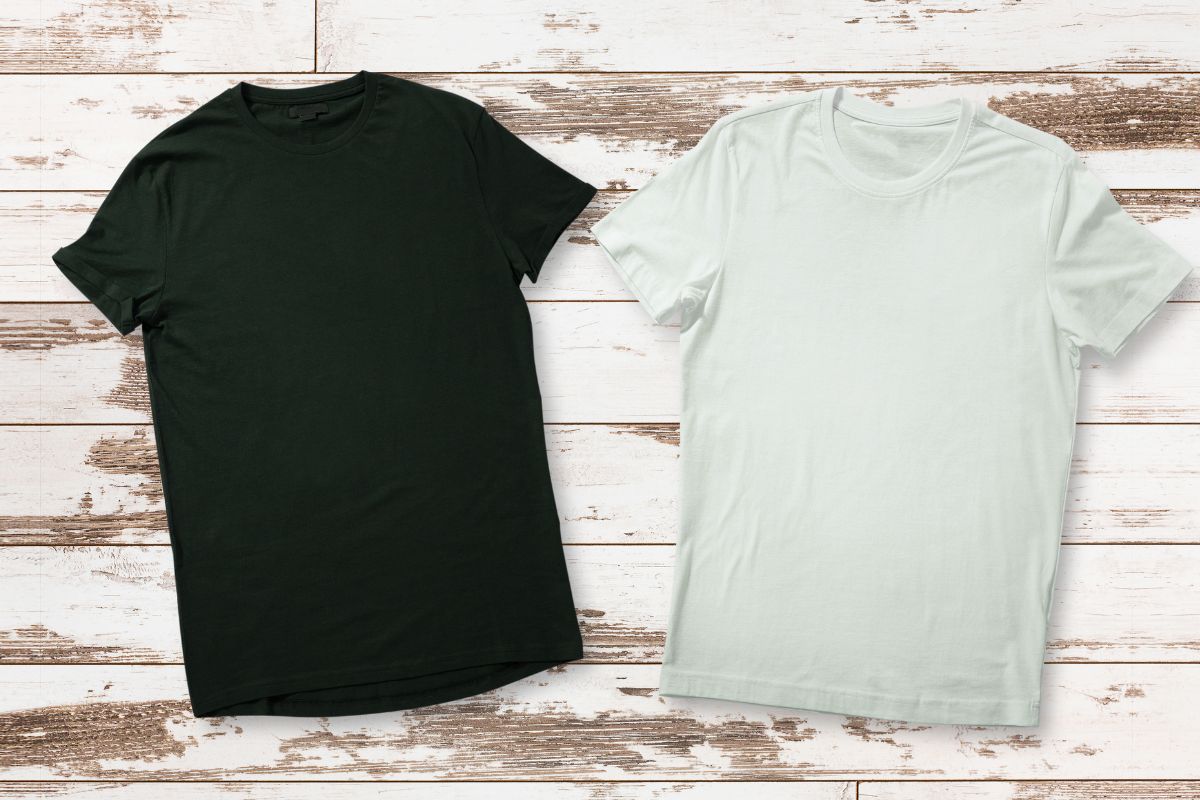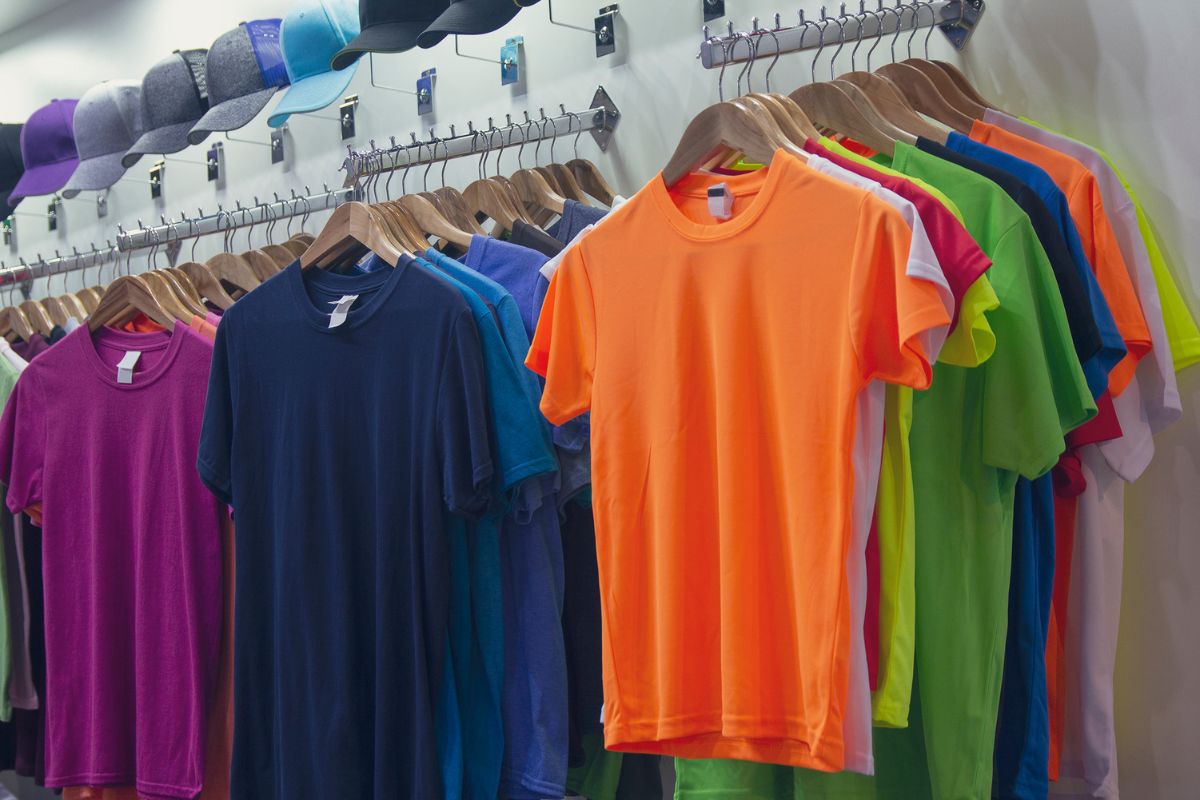The T-shirt is more than just a piece of clothing. Its history stretches from humble beginnings to a symbol of expression and identity. Starting from its origins as an undergarment in the late 19th century, T-shirts have transformed into acultural icon.
Table of contents
- Key Takeaways
- Origins of the T-Shirt
- Material and Design Evolution
- Cultural and Fashion Breakthrough
- Political and Social Statements
- Brand and Marketing Evolution
- Technological Advancements in T-Shirt Printing
- T-Shirts in Popular Culture
- Extending the Function of T-Shirts
- Global Trends and Future Directions
- Conclusion
- Frequently Asked Questions
- When were the first T-shirts introduced to the public?
- Who is credited with the invention of the T-shirt?
- How did T-shirts evolve into a fashion item from their original use?
- Why are T-shirts referred to by the letter ‘T’ in their name?
- When did T-shirts begin to feature printed designs or graphics?
- Can you trace the development of women’s T-shirts and their origins?
In the mid-20th century, T-shirts became popular among teens and young adults, largely thanks to Hollywood stars like James Dean and Marlon Brando. The 60s and 70s saw T-shirts becoming canvases for political and social messages, cementing their place in protest culture. Today, T-shirts are used to showcase everything from personal beliefs to brand loyalty.
Whether it’s through advancements in fabric and printing technology or their role in fashion and culture, T-shirts have become a staple inwardrobes around the world. Their journey reflects changes in society and technology, making them an ever-evolving medium of personal expression.
Key Takeaways
- T-shirts began as undergarments in the late 19th century.
- Hollywood in the mid-20th century helped make T-shirts popular with the masses.
- Today’s T-shirts are symbols of personal, political, and cultural expression.
Origins of the T-Shirt
The T-shirt’s history is rich, and its transformation from a piece of undergarment to afashion staple is fascinating. Key influences include 19th-century undergarments, the Spanish-American War, and the U.S. Navy.
19th Century Undergarments
In the 19th century, men’s undergarments were quite different from today’s T-shirts. One of the most common undergarments was the union suit. A one-piece garment with buttons, the union suit covered the body from neck to ankles. Over time, people started to modify this design.
The top half of the union suit became a separate garment known as an undershirt. These undershirts were practical and provided comfort. They were usually made of cotton, making them soft and breathable. This design shift set the stage for themodern T-shirt, which retained the simplicity and functionality of these early shirts.
Spanish-American War Influence
In the late 19th century, the Spanish-American War played a role in popularizing undershirts. Soldiers from tropical climates needed lightweight clothing. The heat made traditional uniforms impractical.
To solve this, the military issued these lightweight undershirts to keep soldiers cool. This practical solution quickly gained favor among the troops. You can trace the modern T-shirt back to this need for functional and comfortable clothing. This period marked a significant transition in the T-shirt’s history from an undergarment to a standard part of soldiers’ attire.
U.S. Navy Adoption
The U.S. Navy adopted the T-shirt in the early 20th century. By 1913, the Navy had made the white cotton T-shirt part of its official underwear for sailors. This move was to ensure practicality and hygiene. Sailors needed easy-to-clean and lightweight options suitable for various tasks on ships.
These shirts were well-suited for sailors working below decks, offering a snug fit without excess fabric. The acceptance of the T-shirt by such a prominent institution helped cement its place in daily wear. Eventually, it became popular outside the military, leading to the casual and athletic T-shirts you see today.
By understanding these origins, you can see how the T-shirt evolved from a simple undergarment to a versatile and essential piece of clothing.
Material and Design Evolution

The history of the T-shirt is rich and spans several important developments in both materials used and design aesthetics. This section explores the key transitions from basic fabric to modern design innovations.
Fabric Innovations
The journey of the T-shirt began withtraditional cotton, known for its softness and breathability. Over time, new materials emerged, enhancing its comfort and durability. In the mid-20th century, polyester and cotton blends were introduced, providing both strength and flexibility.
- Cotton: Dominated early T-shirt production due to its comfort.
- Polyester-cotton blends: Popular in the 1970s for added durability.
- Modern innovations: Include moisture-wicking and antimicrobial fabrics, transforming the T-shirt into a high-performance garment.
These advancements made the T-shirt more versatile and suitable for various activities.
From Undershirt to Fashion Statement
Originally, T-shirts were simple, white undershirts. During World War II, soldiers wore them as part of their uniform, highlighting their practicality. Post-war, the T-shirt evolved from functional underwear to a casual fashion staple.
- 1950s: Marlon Brando and James Dean popularized T-shirts, making them symbols of rebellion.
- 1960s-70s Hippie culture: Adopted T-shirts as canvases for self-expression.
- 1980s-onwards: Graphic T-shirts became a medium for personal and political messages.
This shift from undershirt to statement piece marked a significant cultural evolution.
Modern T-Shirt Characteristics
Today’s T-shirt incorporates advanced designs and materials. They often feature improved fits, soft-hand fabrics, and sustainability considerations. Jersey fabric is a common choice due to its stretch and comfort.
- Fit styles: Range from slim-fit to oversized.
- Fabric: Includes organic cotton and recycled materials, stressing eco-friendliness.
- Technological enhancements: Such as UV protection and odor resistance, cater to modern needs.
The modern T-shirt is a blend of fashion and function, reflecting advancements in both design and material technology. This evolution highlights its adaptability and enduring popularity.
Cultural and Fashion Breakthrough

T-shirts have not only served as basic clothing but have also become symbols of culture and fashion. Their journey through the decades highlights significant cultural shifts and fashion revolutions.
Hollywood’s Influence
Hollywood played a crucial role in transforming the T-shirt from simple underwear to a fashion statement. In the 1950s, actors like Marlon Brando and James Dean showcased T-shirts in films such as A Streetcar Named Desire and Rebel Without a Cause. These appearances made T-shirts synonymous with youthful rebellion.
Seeing these iconic figures in plain tees inspired young people to adopt this look. Hollywood’s portrayal of T-shirts also made them trendy and acceptable as outerwear. The influence of these films carried over into the 1960s, as more people began to embrace the casual, rebellious look popularized by their favorite stars.
Rebellion and Self-Expression
T-shirts quickly became a canvas for self-expression, providing a means for individuals to showcase their identities. In the 1960s and 1970s, the T-shirt culture exploded, particularly among youth counterculture movements. They were used to convey political messages, social causes, and personal beliefs.
By wearing T-shirts, you could outwardly display your support for various causes or music bands. Punk rock and other subcultures adopted band tees as a way to express their affiliation with specific music genres. The Rolling Stones’ tongue logo became an iconic symbol featured on many T-shirts, representing not just a band but an entire movement.
Graphic Tees and Logos
Graphic T-shirts emerged as a powerful form of communication. Brands and designers realized the potential of T-shirts for advertising and artistic expression. By the late 20th century, graphic tees became a staple in fashion, featuring everything from company logos to elaborate designs.
Logos and graphics on T-shirts allowed you to make bold fashion statements and align yourself with particular brands or trends. Band tees, such as those featuring the Rolling Stones’ tongue logo, became popular, highlighting the interconnectedness of music, art, and fashion. Graphic T-shirts continue to be a versatile and popular choice, serving as both fashion items and personal billboards.
Through Hollywood, rebellion, and graphic design, T-shirts have evolved into an essential element of cultural and fashion history. They reflect broader societal changes and allow individuals to communicate their identities and affiliations vibrantly.
Political and Social Statements

T-shirts have been a canvas for political and social messages. They allow people to express their views on various issues openly. This section explores two important aspects: the role of protest and slogan tees and the influence of music and bands.
Protest and Slogan Tees
Protest and slogan tees have become a key part of political movements. During the 1960s, groups like Students for a Democratic Society (SDS) used T-shirts to spread messages about social and political issues. T-shirts with printed slogans became popular tools for raising awareness and showing solidarity.
In recent times, these tees continue to be important for causes like environmental activism and human rights. For example, messages about climate change and racial equality are often seen on T-shirts during protests.
The method of printing these T-shirts has also evolved. Initially, screen printing was common, requiring stencils and ink. Now, digital printing technology allows for more complex designs and quicker production. This has made it easier for activists to distribute T-shirts with clear, bold messages.
Music and Band Influence
Music has also played a major role in the popularity of political and social statement T-shirts. Bands often use T-shirts to share their views on various issues. During the 1970s and 1980s, punk rock bands produced T-shirts that carried rebellious and anti-establishment messages.
These T-shirts not only promoted the band but also connected fans with the political causes the bands supported. For instance, bands like The Clash and Dead Kennedys used their merch to address issues like war and censorship.
Today, many artists continue this tradition. Bands and solo artists print T-shirts to support causes such as LGBTQ+ rights and mental health awareness. These T-shirts often feature bold slogans or symbolic imagery, making them a powerful medium for communication.
Brand and Marketing Evolution
T-shirts have become powerful tools for branding and marketing. From corporate logos to high-end fashion brands, the evolution of how T-shirts are used to convey brand identity has significantly shaped their history.
Corporate Branding with Tees
Companies like Coca-Cola and Disney have long utilized T-shirts to promote their brands. These shirts aren’t just for sale; they are given away at events or used as uniforms. This strategy helps reinforce brand identity and creates walking advertisements.
The use of T-shirts as a marketing tool began in the early 20th century. For example, the P.H. Hanes Knitting Company started making T-shirts that eventually became a staple in American wardrobes. Similarly, Sears played a significant role in distributing branded T-shirts, making them accessible to a wide audience.
Branded T-shirts also serve as collectibles, capturing moments in time and marketing campaigns. This marketing method sustains brand loyalty and creates a community around the brand.
Fashion Brands and Designer Tees
High fashion brands like Dior, Yves Saint Laurent, and Calvin Klein have transformed T-shirts from basic garments into stylish statements. Designer T-shirts often feature bold logos, unique designs, and high-quality fabrics, making them coveted fashion items.
These brands utilize T-shirts to mix luxury with everyday wear, expanding their market. The rise of designer T-shirts in the 1980s and 1990s showed how these pieces could serve as both fashion statements and status symbols.
Fashion designers have also used T-shirts for runway shows and marketing campaigns, creating a limelight around a simple piece of clothing. This trend demonstrates how the T-shirt has evolved beyond utility to become an integral part of fashion and identity.
Technological Advancements in T-Shirt Printing

Technological advancements have revolutionized t-shirt printing, making it more efficient and accessible. Two major areas of development include screen printing techniques and innovations in custom t-shirt creation.
Screen Printing Techniques
Screen printing has been around for decades and remains one of the most popular methods for t-shirt printing. This technique uses a mesh screen, ink, and a squeegee to transfer designs onto fabric.
Recent advancements have improved the precision and speed of screen printing machines. Automatic screen printing machines now allow for faster production without sacrificing quality. They can handle more colors and intricate designs, making them ideal for mass production.
Digital printing screens are another breakthrough, allowing for more detailed and vibrant designs. Traditional screens required manual washing and preparation, but digital screens can be reused, reducing waste and time.
These advancements have made screen printing more versatile and efficient, ensuring high-quality prints with every batch.
Custom T-Shirt Innovation
Custom t-shirt creation has benefited greatly from new technologies. The development of direct-to-garment (DTG) printing allows for printing directly onto fabric using inkjet technology. This method is perfect for small batches or individual custom t-shirts because it requires no screens or setup.
Sublimation printing has also gained popularity. This technique involves transferring dye onto the fabric using heat, resulting in vibrant and durable prints. It is especially effective on polyester fabrics.
Online platforms now let you design your own t-shirt easily. These websites use advanced software to preview your design on a virtual t-shirt, making the customization process straightforward and fun.
Advances in t-shirt printing technology continue to evolve, providing endless possibilities for creativity and personalization. These innovations make custom t-shirts more accessible and high-quality than ever before.
T-Shirts in Popular Culture

T-shirts have become more than just casual wear; they reflect cultural moments, trends, and personal identities. Their influence spans across celebrities, the music scene, and film and television wardrobe choices.
Influence of Celebrities and Models
Celebrities and models have made t-shirts iconic. In the 1970s, music icons like Mick Jagger and Debbie Harry turned the plain white t-shirt into a symbol of rebellion and style. In the 1980s and 1990s, supermodels like Kate Moss popularized designer t-shirts, making them a staple in high fashion.
The trend continued in the 2000s with celebrities often spotted wearing branded or graphic tees. From graphic tees to slogan t-shirts, stars like Rihanna and Kanye West have influenced t-shirt trends, making them integral pieces in modern wardrobes. These influences have solidified the t-shirt’s place in both casual and high fashion circles.
Music Scene and Its Impact
The music scene, especially in the 1990s, had a huge impact on t-shirt culture. Grunge bands like Nirvana and Pearl Jam made band t-shirts a symbol of the era. These t-shirts were more than just merchandise; they became part of the identity for fans and music lovers.
In the 2000s, band tees remained popular, often seen as vintage fashion staples. Concert-goers and fans continued to wear these shirts as badges of their musical tastes and affiliations. The influence of the music scene on t-shirt culture demonstrates the garment’s power in expressing personal and cultural identity.
Film and Television Wardrobe
Film and television have showcased t-shirts in ways that made them iconic. The 1939 classic The Wizard of Oz may not feature t-shirts prominently, but modern movies like Rebel Without a Cause brought the white t-shirt into mainstream fashion in the 1950s.
In the 1980s and 1990s, TV shows like Friends and movies like Pulp Fiction featured characters wearing memorable t-shirts, making them part of popular culture. Wardrobe choices in film and television continue to influence t-shirt trends, cementing their role as versatile and essential pieces in everyday fashion.
Extending the Function of T-Shirts

T-shirts have evolved significantly from simplecasual wear to multifaceted garments. They now serve purposes in various domains, including sports, fashion, and art.
Activewear and Versatility
T-shirts are a staple inathletic wear for both men and women due to theircomfort and functionality.Moisture-wicking andbreathable fabrics make them ideal for workouts, keeping you dry and cool. Technological advancements in fabric production have led to T-shirts that are not only lightweight but also durable and quick-drying.
High-performance T-shirts often feature anti-odor technology and UV protection. These features make them suitable for diverse activities, from gym sessions to outdoor adventures. You can find versatile designs that transition seamlessly from exercise to casual outings, making them a practical choice for active lifestyles.
T-Shirts in Art and Designer Collaborations
The intersection of T-shirts with art and fashion has given rise to unique cultural expressions. Artists and designers frequently use T-shirts as canvases, creating limited-edition prints and collaborations. This trend has blurred the lines between high fashion and everyday wear.
Fashion houses and famous designers collaborate on exclusive T-shirt collections that feature distinctive logos, graphics, and messages. These items often become collectible pieces due to their unique designs and limited availability. Such collaborations highlight the versatility of T-shirts in expressing personal style and artistic vision, making them more than just basic apparel.
By exploring these domains, T-shirts continue to extend their function beyond mere casual wear into essential and expressive elements of modern apparel.
Global Trends and Future Directions

T-shirts have evolved from simple undershirts to a staple in global fashion. Today, several key trends and future directions define the market’s landscape.
Trends
- Sustainable Fashion: Increasingly, brands are focusing on environmentally friendly materials and ethical production methods. This move addresses the growing consumer demand for sustainable clothing. Explore more about this trend in this research.
- Customization: Personalized T-shirts have become popular. People enjoy unique designs that reflect their personalities. This trend is particularly strong in cities like New York, where individuality is prized.
Cut and Style
- Modern Cuts:Classic cuts remain popular, but modern, innovative cuts are emerging. For example, asymmetrical hems and oversized fits are finding their place in the market. Updated designs keep T-shirts fresh and trendy.
- Graphic Tees: Bold graphics and logos are still in demand. These shirts often inspire fashion trends, making a statement while being easy to wear.
Future Directions
- Technology Integration: The future may see T-shirts integrated with technology, such as built-in LEDs or smart fabrics that change color. This innovation could revolutionize daily wear.
- Water-Based Printing: Environmentally friendly printing methods, like water-based inks, are expected to rise. These inks are less harmful to the environment compared to traditional methods.
Inspiration from the Past
Vintage Revival: Retro T-shirt designs are making a comeback. Styles from past decades inspire current trends, proving that fashion is cyclical.
Fashion always changes, but T-shirts remain a constant canvas for expression and innovation. For more insights on historical and future fashion trends, check this guide.
Conclusion
T-shirts have transformed over time from simple undergarments to powerful symbols of culture and protest. You’ve seen them evolve through different eras, picking up various roles and meanings.
In the early 20th century, T-shirts were mainly worn by sailors and laborers for their practicality and comfort. By the mid-20th century, T-shirts became popular casual wear, especially after being popularized by movie icons.
Today, T-shirts serve as wearable diaries and tools for expressing beliefs, making them not just fashion items but means of communication. They are often used in protests and campaigns, signifying various social and political statements.
From rock band logos to political slogans, T-shirts allow you to share personal experiences and make statements about your world views.
They reflect trends and societal changes, making them a staple in your wardrobe and a part of your daily life. The T-shirt, with its rich history and versatile use, is a unique piece of clothing that continues to adapt and hold meaning.
Frequently Asked Questions
Learn about the key moments and figures in the history of T-shirts, from their invention and transformation into fashion items, to the origins of women’s T-shirts and the introduction of printed designs.
When were the first T-shirts introduced to the public?
The first T-shirts were introduced to the public in the early 20th century. They became popular around the 1910s when the U.S. Navy began issuing them as underwear.
Who is credited with the invention of the T-shirt?
The T-shirt’s invention is credited to the Cooper Underwear Company, which developed a one-piece union suit in the late 19th century that ultimately evolved into the separate T-shirt.
How did T-shirts evolve into a fashion item from their original use?
T-shirts transitioned from an undergarment to a fashion item in the 1950s. This shift was influenced by Hollywood stars like Marlon Brando and James Dean, who wore T-shirts in movies, making them a symbol of rebellion and style.
Why are T-shirts referred to by the letter ‘T’ in their name?
T-shirts are named for their shape, which resembles the letter ‘T’. This simple design includes a body and sleeves that form a T-like outline.
When did T-shirts begin to feature printed designs or graphics?
T-shirts began featuring printed designs or graphics in the 1940s. This trend started with the U.S. military, which printed logos and slogans on T-shirts for servicemen during World War II.
Can you trace the development of women’s T-shirts and their origins?
Women’s T-shirts emerged in the 1960s, coinciding with the unisex fashion movement. Designers began creating T-shirts tailored to the female form to meet the growing demand for versatile and comfortable clothing.



